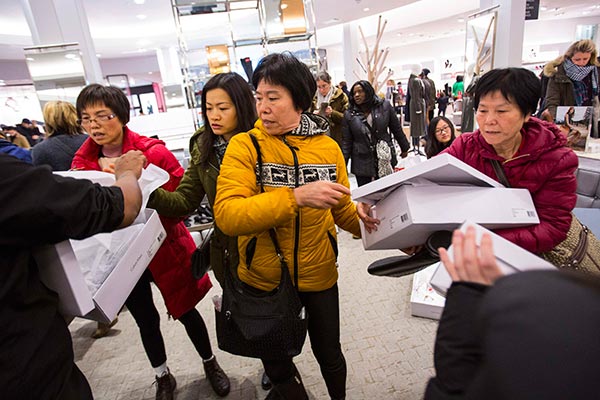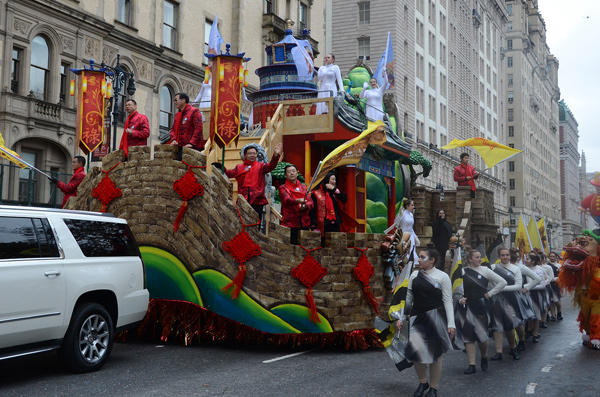
29 Nov, 2014
Macy’s says “huanying” to Chinese tourists
New York, (China Daily USA), 2014-11-28 – The presence of a China-themed float in the Macy’s Thanksgiving Day Parade for the first time was perhaps symbolic of the rising importance of Chinese customers to one of the world’s largest department stores.
|
The Macy’s in Herald Square in New York has undergone a $400 million renovation over the last four years, reorganizing its main floor where handbags and cosmetics are located, revamping its shoe store – which the company says is the biggest in the world at the size of two football fields – and most importantly, bringing in new high-end luxury brands like Gucci, Burberry and Longchamp.
International tourists are making up more of Macy’s business, including the high-spending Chinese, who spend more in the US than any other foreign visitors. Macy’s has seen traffic from Chinese visitors grow in the last several years, particularly those headed to the Herald Square store.
“It’s really increasing by leaps and bounds,” said Kristen Esposito, vice-president of tourism marketing and development. “The UK used to be our No 1 group, now the Brazilians are outpacing them and the Chinese are right behind.”
Macy’s gets more Chinese visitors by volume at its West Coast locations, but the company has seen a significant increase in tourists as they move East. The Herald Square location is starting to log up to 30 to 40 percent more tourists a month, Esposito said.
“Cities like New York and Chicago and Boston are high-penetration, with a lot of the direct flights that are now coming from China to these cities,” she said. China Southern Airlines launched a new direct flight between New York and Guangzhou in August, which came shortly after a direct Boston-Beijing Hainan Airlines route in June.
Macy’s tailors its locations to its customers, and for the large numbers of Asian visitors who visit the Herald Square location, it has expanded its brand lineup to include more American lines. American designer labels cost more in China, so the Chinese love to bring back clothes from names such as like Ralph Lauren Polo, Tommy Hilfiger and Michael Kors when they’re visiting the US, Esposito said.
Handbags, accessories, cosmetics and fragrances are top items that the Chinese shop for when they visit Macy’s Herald Square, said Esposito, and those items are located in the main floor adjacent to the luxury shops within the department store.
“It’s the convenience of having a one-stop shop. To shop at Woodbury Commons (50 miles north of New York) – who is a competitor of ours – they would have to get on a bus for an hour,” said Esposito. “We’re very promotional, and we have very competitive pricing. I think that that’s the exciting thing about Macy’s, because we have price points for everybody, where we have moderately priced shoes and then you have shoes from Gucci or Louis Vuitton that can run to $1,000 a pair.”
Macy’s has appeared on Chinese social media platforms to raise brand awareness for US-bound tourists.
 Women pass boxes of shoes in Macy’s to kick off Black Friday sales in New York November 27, 2014. Select stores opened Thursday to kick off the Black Friday sales, with the Friday after Thanksgiving typically being the busiest shopping day of the year in the US. [Photo / Agencies] |
“It’s more of a tourism platform; it’s talking about what they can expect in Macy’s,” Esposito said. “They may not realize we carry a lot of the luxury brands; the shopping and the dining experiences we have to offer,” Esposito said.
“We’ve done some studies, and everybody really recognizes the Macy’s brand, but what we found as we started to really delve in, we found that they really see us as that mid-tier department store, and we’re really not, especially in Herald Square,” she said. “You can get all your prestige brands – whether it be from cosmetics to fragrances to those high-end designers – the social media is really a way for us to get out and show what brands we have here,” Esposito said.
Recently on Singles Day – China’s equivalent to Black Friday shopping on Nov 11 – Chinese shoppers living in the US were alerted on social media that they were eligible to pick up a VIP shopping pass at nine different Macy’s locations across the country.
“While it wasn’t e-commerce, people were able to come in and say, ‘Macy’s recognizes today is Singles Day, and I’m in the United States,'” Esposito said.
The department store does not record sales revenue categorized by ethnic group, but revenue for the company in 2013 was $27.9 billion, up from $25 billion in 2010. About 20 million visitors pass through the store annually. Esposito said that in the company’s key locations, it is seeing about 15 to 20 percent growth from Chinese customers over the last year.
The company also has partnered with NYC & Co, the city’s official tourism bureau, to revamp its visitor center at the Herald Square store. Chinese visitors who come with tour groups often are given 10 percent-discount passes that they can pick up only at the visitor centers. In addition, the visitor centers provide information on all of the city’s outer boroughs and activities outside of Manhattan. Mandarin speakers are available to help with Chinese tourists.
“In alignment with Macy’s multimillion-dollar renovation, we thought this was a perfect fit, perfect audience for us to capture, because we get a lot of international visitors,” said Christopher Heywood, senior vice-president of global communications at NYC & Co. “We thought it was a win-win partnership with Macy’s.”
New York City also has been making a push to attract Chinese tourists, the Big Apple’s fourth-largest group of international visitors. The tourism bureau recently sent a 10-member team to promote the city in China and participated in the China International Travel Mart, an annual travel trade show in China.
“New York City is quite China-ready,” Heywood said. “Our message has really been about the vibrancy and the excitement of New York City, and also how the city is ready to welcome Chinese visitors with open arms.”




Liked this article? Share it!